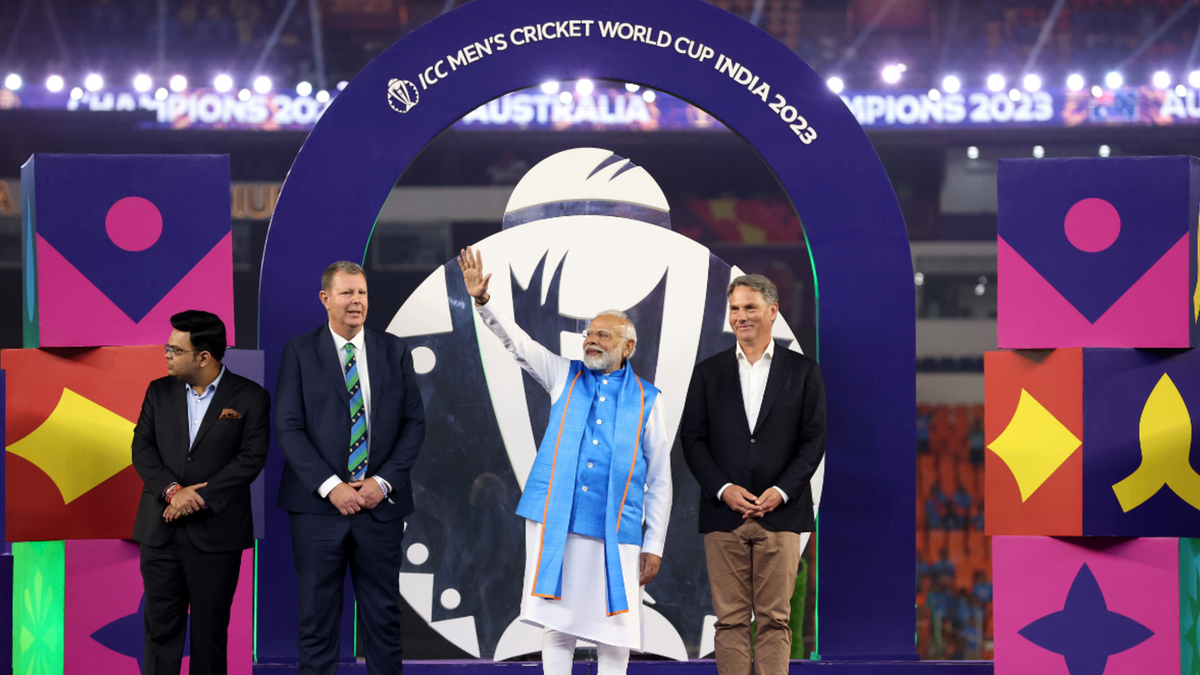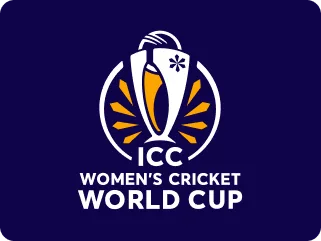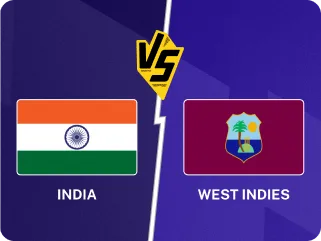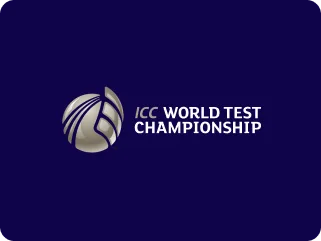
Writing in the 2024 edition of the Wisden Almanack, Sharda Ugra dissects the growing influence of Indian politics on Indian cricket.
On one level, the 2023 World Cup was business as usual, confirming the wealth, power and resources available to Indian cricket, and culminating in another title for Australia. But there was a parallel tournament, in which the cricket became a platform for the political ideology of the ruling Bharatiya Janata (Indian People’s) Party, with a sharp focus on amplifying the personality cult of the prime minister, Narendra Modi, in the run-up to 2024 general election.
The messaging was easily carried out: Jay Shah, secretary of the Board of Control for Cricket in India, is son of the country’s home minister, Amit Shah; naturally, Shah jnr has a direct line to BJP headquarters. With the Indian team playing a thrilling brand of cricket, packing stadiums and grabbing eyeballs, the political messaging stayed on high beam – until the final, that is, when it gave way to a bad aftertaste.
Had the World Cup been merely about BCCI attempts to control what went out on the global TV feed, the muscle-flexing would have been familiar. But this was a different kind of BCCI command-and-control over what, in theory, was an ICC event. By disregarding first the schedules, then the consequences of doing so, the Indian board hijacked the World Cup, and used it – wherever they could – as a propaganda tool for the government. The ICC demonstrated neither the nous nor the spine to resist the takeover.
The BCCI have always had politicians in their ranks, from across the ideological spectrum. But a former board employee who had worked with figures from various parties said they had “no involvement in the direct administration of the game… Across parties, they never politicised the scene, or brought any political outfit into the administration.”
By 2023, though, the BCCI had changed. Piggybacking on the Indian team, they treated the tournament as a vehicle for jingoism and exceptionalism, repeatedly trumpeting the BJP’s pet tropes: hyper-nationalism, and anti-Pakistan and anti-Muslim sentiment. And behind the semaphore was Jay Shah. The World Cup was a test of his efficiency, an Indian victory his intended offering to the BJP – and to Modi, in the stadium named after him in Ahmedabad, his old power base when he was chief minister of Gujarat between 2001 and 2014. The tournament was meant to be the execution of a broader regime plan, to present a new assertive Indianness – not to the cricketing world, but to the party’s huge domestic constituency, and to the nation’s vast diaspora.
Political messages, both official and unofficial, had been tried out well in advance. Ahmedabad’s stadium, whose inaugural event had been a fawning political rally with US president Donald Trump in 2020, was officially named after Modi a year later, before the third Test against England. Then, in March 2023, on the morning of the fourth Test against Australia, the teams warmed up in the practice nets, because Modi and his Australian counterpart, Anthony Albanese, were enjoying a lap of the stadium in a golden chariot remodelled from a golf cart, waving to a sparse crowd. (BJP plans to bus in thousands of spectators, and create a world-record attendance, fell flat.) These were among the many seeds sown for the World Cup: the Gujarat Cricket Association – where Modi and Shah snr had been presidents, and Shah jnr secretary – and the Narendra Modi Stadium became the central command of the political project.
Other arms of the government were also put to use. Months before the tournament, cricket reporters applying for visas from three countries (though not Pakistan) were invited in by Indian diplomatic missions for casual chats about their credentials. Two journalists were asked to sign undertakings they would not report on anything other than the cricket.
The BCCI’s refusal to travel to Pakistan for September’s Asia Cup meant that nine of the 13 scheduled games were moved to Sri Lanka. The first of two India–Pakistan matches, held in Kandy, offered a preview of the World Cup mood. Within 15 minutes of entering the box belonging to the chair of the Pakistan Cricket Board, IPL chair Arun Dhumal began receiving messages and calls asking him to return to the BCCI box: fraternising with the PCB was not on, and Dhumal did as he was told. The next time he appeared on TV, he was sitting next to Shah jnr, the Indian tricolour daubed on his cheeks.
As a partnership between Ishan Kishan and Hardik Pandya set about rescuing India that day, the PA system began to play “Ram Siya Ram”, a chorus from an old Hindu bhajan (devotional song) which had featured in a new film. To Indians, its significance was obvious. Over the last three decades, the Hindu god Ram has been appropriated as the BJP’s deity of choice, with fundamentalists turning the chant – “Jai Shri Ram” – into a call to arms.
The Sri Lankan DJ was playing the chorus on the orders of the Asian Cricket Council, whose president is Jay Shah. Eventually, Pakistan – the tournament hosts, remember – took control of the music. It was no coincidence that, during the World Cup, the song reappeared during the India–Pakistan match at the Narendra Modi Stadium on October 14. Young Indians among the ICC volunteers eventually had it removed from the playlist for the rest of the tournament. A Hindi-speaking journalist and YouTuber, Shyam Meera Singh, summarised the zeitgeist, saying the BJP “had already turned the BCCI into one of its many party units”.
This was felt with particular force by Pakistan and, to a lesser degree, by Bangladesh, another Muslim neighbour. To start with, there had been a delay in issuing visas to the Pakistan team, obliging them to cancel a training camp in Dubai, and land in India only two days before their first warm-up. Pakistani reporters – and British reporters with links to Pakistan – had to wait longer, missing their team’s tournament opener against the Netherlands in Hyderabad, their first match on Indian soil in over seven years. For those two games, press conferences had to be conducted for their reporters over WhatsApp. With visas issued at the last hour – though for just 11 of the 65 applicants – Pakistani journalists made a dash to the Attari–Wagah border crossing in Punjab. They were then told their visa would last only as long as their team were in contention; just one succeeded in staying on for the knockouts. Since the BCCI secretary has the home minister on speed dial, these were easily avoidable hurdles. It was hard to escape the conclusion that their purpose was to humiliate.
Meanwhile, the fact that the competition’s schedule was released with only 100 days to go, then revised for nine games, confirmed how little the BCCI cared for overseas fans. The World Cup was treated like a copy-and-paste version of the IPL: just another event in Indian cricket’s self-sustaining greenhouse, with conditions prepared accordingly. Since travelling supporters numbered perhaps no more than a thousand, TV crews struggled to find different fans and flags, which would have brought colour to their broadcast. The crowds’ uniformity did not go unnoticed. Only ten days into the tournament, The Sydney Morning Herald headlined a piece: “How India took the world out of World Cup”.
Tournament staff travelling between the ten host cities found working in Ahmedabad trickiest. “Most other venues for India games were reasonably free from external interference,” said one. “Except Ahmedabad: everything was amped much more.” There, event managers came across an official whose identity remained a mystery, and whose approach was confrontational. “It was like: ‘Who are you? We don’t care who you are. What is the ICC? We will do what Mr Shah says. Mr Shah wants this or that. This is Ahmedabad.’”
Much happened in Ahmedabad. It was where local BJP party workers were given free tickets to distribute for the curtain-raiser between England and New Zealand, in a bid to pack the stands with women – recognition, apparently, for a government bill legislating that 33 per cent of parliamentary seats be reserved for women. The move couldn’t disguise the fact that no opening ceremony had been planned. Ahmedabad was also where rumours proliferated that the BCCI had made only 4,000–5,000 tickets per India game available for sale on the official ticketing website, allowing them to distribute the bulk of the public tickets to local BJP party offices or other agencies, from where they would be used as handouts, or sold at ten times the face value. In September, a complaint was made to the Grievances Appellate Committee, alleging that the ticket-reselling website Viagogo was breaking Indian e-commerce law by offering tickets at inflated prices – a Rs4,000–5,000 (£40–50) ticket for India v Pakistan was on sale at Rs400,000 (£4,000). And Ahmedabad provided what was the dream – or nightmare – template for an Indian World Cup match: against Pakistan, a hypermanic DJ played patriotic songs, while the crowd ignored or jeered their opponents’ efforts, with most abuse coming from the highest-priced stands. (The Indian players were said to be dismayed by the booing and heckling.)
There were at least two reported incidents of overseas fans being bullied or roughed up. In Bangalore’s Chinnaswamy Stadium, a policeman tried to stop a lone Pakistani fan cheering for his country, until his efforts were recorded on video. In Pune, a group of India supporters pushed and shoved Tiger Shoaib, a well-known Bangladesh fan, snatching his stuffed tiger mascot and tearing it to shreds. Outside some venues, it was hard to buy Pakistani replica caps or shirts, with vendors keen to avoid being taken to task by a passing zealot. The Indian team’s smooth progress received a scratch when the Daily Mail reported that the pitch for the semi-final between India and New Zealand at Mumbai had been switched to a used surface without the permission of the ICC’s pitch consultant, Andy Atkinson. This didn’t affect the outcome of the game, which India won easily, but commentators were told to avoid references to it, and the ICC embarrassed by the clear implication: the BCCI, not they, were running the show. Both organisations put out a lame statement suggesting pitch switches were common in long tournaments.
Before the final, an Indian Air Force aerobatics team carried out a flypast, unusual at a cricket match, and possible only on government demand. Meanwhile, it emerged that India’s two World Cup-winning captains, Kapil Dev and M. S. Dhoni, had not been invited. One explanation was incompetence, though Kapil had not endeared himself to the BJP by co-authoring a letter with several team-mates from the 1983 team objecting to the authorities’ public manhandling of Indian Olympic wrestlers, who were protesting against the conduct of the head of the wrestling federation, a BJP MP. And while Kapil was absent, Ranveer Singh – the actor who played him in the film 83 – was invited.
During the game, social media breathlessly tracked Modi’s movements on his way to the stadium, which disappeared from the newsfeed as the match tilted Australia’s way. Following India’s mediocre total of 240, the mid-innings entertainment – another last-minute BCCI addition – had a singer belt out a number from 83. The words rang out: “Jeetega jeetega, India jeetega”: “Win, win, India’s going to win”. As Travis Head set about ensuring otherwise, the atmosphere grew funereal. TV crews were told not to show BCCI officials on air, unless India’s fortunes improved, while Jay Shah was seen wandering around, his plans in disarray, his dream disintegrating. Modi had committed to handing out the trophy, and did so – though to Pat Cummins, not Rohit Sharma, in a haphazard ceremony. He followed this with a visit to the Indian dressing-room to offer commiserations. Yet this was not a moving, private moment: Modi was miked up by his diligent camera team as he went around meeting the players, with Amit Shah in tow. It was the final political touch to the BCCI’s World Cup.
It is ironic that the most brazen plan of all – a last-minute switch of the Indian jersey from blue to orange before the Pakistan match – proved unsuccessful. BCCI treasurer Ashish Shelar called the story “absolutely baseless, and a work of someone’s imagination”. But three independent sources – one each from the team, the ICC and the BCCI – have confirmed the existence of an all-orange uniform, which was presented to the team as an alternative two days before the game. They had already been given a new training kit – an orange shirt and dark trousers – a week before their first fixture. When the all-orange kit arrived in the dressing-room, the players looked nonplussed, according to an insider. Here, the story split into two versions. One, out first, said the uniform was rejected because it “looks like Holland”. The other had the Indian cricketers saying to each other: “This is not on… We won’t do it… It is disrespectful to some of the members of the team.”
Why disrespectful? Orange is the colour worn by Hindu priests, sages and mendicants; orange flags flutter over Hindu temples. But the colour has been appropriated as a symbol of hard-line Hinduism (Hindutva) by the BJP, now completing ten years in power. BJP cadres flaunt orange scarves, their rallies are awash with saffron. Green is regarded as the counter-colour, used in Islam in mosques and shrines, and on flags. To kit out the Indians in all-orange against the Pakistanis, in their familiar dark green, would have turned a high-voltage match into Hindu India against Muslim Pakistan. There were two Muslims in the Indian team, Mohammed Shami and Mohammed Siraj.
The ICC say the all-orange kit was presented to them by the BCCI as part of UNICEF’s “One Day For Children” event held at every World Cup. Four years earlier, against England at Edgbaston, the Indians had worn a half-blue, half-orange jersey, which was auctioned off for charity. This time, the event had been earmarked for India’s game against Sri Lanka in Mumbai on November 2, not against Pakistan nearly three weeks earlier. But the BCCI weren’t interested in the all-orange versus Sri Lanka. When images of the uniform, complete with ICC and World Cup logos, did the rounds online, the BCCI began receiving queries, prompting Shelar’s denial.
All through the World Cup, the Indian team conducted themselves with sharpness on the field, and composure off it, whatever the pressure they faced from fans or politicians. There had even been a push to rename the team “Bharat” – the Sanskrit word for India. It was supported by the likes of Virender Sehwag and Sunil Gavaskar, but died a quick death. Then came the orange training shirt, followed by the all-orange kit. Each man in the squad, and every Indian cricket fan, knows the day may come when their playing uniform turns orange. Yet, at their home World Cup, regardless of the optics, Rohit Sharma’s India chose to say: “Not on our watch, not here, not today.”
There was enormous sadness among Indian fans after the final, but also a celebration of their team’s quality. And if the unsavoury aspects will fade, one statistic will not. It has been a decade since India – whose wealth, influence and control over world cricket is a source of equal parts pride and embarrassment – won an ICC title. The World Cup is set to return to India in 2031. We cannot know what global cricket will look like by then, but we can hope the ICC will have rescued the ethos of their marquee event from the twisted avatar pushed out by the BCCI in 2023.
Sharda Ugra, who lives in Bangalore, spent three decades reporting sport as required by tabloid, broadsheet, news magazine and website, but now writes whatever she wants.
This article first appeared in the 2024 edition of the Wisden Almanack. Buy it here.








